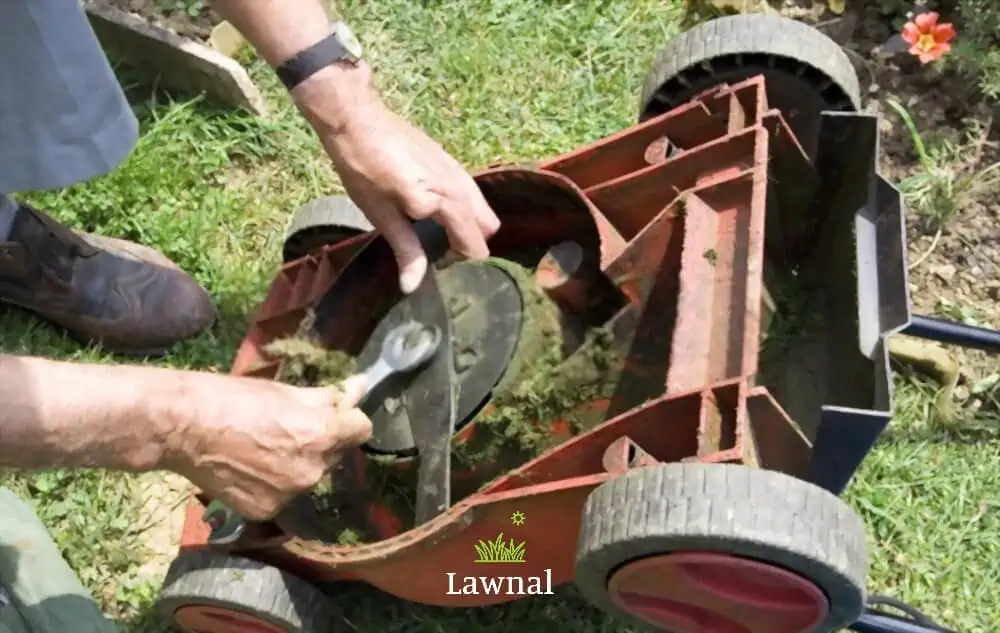Ever wondered why there is netting under your grass? Can you mow over lawn netting without destroying it?
If you live in an area prone to erosion or flood, then netting your lawn is a great way to protect the seeds you planted and maximize their chances of growth.
There are different types of meeting people use to protect their lawns. They can be made from straw, jute, coir, or plastic (I thought we all agreed to protect mother earth?)
Back to the question; is using the lawnmower while the netting is still on the lawn safe?
Can you mow over lawn netting?
No, you can’t mow over the lawn netting. The blades of your lawnmower will be caught in the nets and even cause problems you don’t want.

If you must mow the lawn, remove the netting before anything else. I don’t see why you should remove it before it decomposes. The grass can be mowed 7-8 weeks after seeding, do this only once or twice, as this won’t affect the growth of your seeds.
When it’s about time to mow the grass, remove the netting and just lift it gently off the ground in a rolling movement to avoid uprooting the young seedlings, if any mesh is stuck to the grass, carefully cut these sections loose with gardening shears or scissors.
This will prevent any damage to the grass still attached to the net. Some types of netting are designed to decompose naturally over time. In these cases, it’s usually okay to leave the netting in place and let nature take its course.
How long does it take for lawn netting to disintegrate?
The lawn netting will disintegrate about three years after it is placed; this gives the grass enough time to grow and adapt to the soil against erosion.
However, the time taken to decompose depends on the type of material and its thickness. A less thick netting will disintegrate in less than three years.
Furthermore, biodegradable materials like jute and coir will break down quicker than synthetic materials like polypropylene. Also, environmental conditions like moisture, temperature, soil pH, and microbial activity impact the decomposition rate.
Despite all these factors, the plan is to give the new plant enough time to root and establish itself before the netting breakdown. To ensure this, ensure the netting you choose will last as long as it takes for the grass to regrow.
Mowing over straw erosion blanket
The erosion blanket must be removed completely before mowing the lawn. Reduce the speed of the lawnmower, and don’t go too hard.

If you don’t remove the erosion blanket before mowing, it will get stuck in the lawnmower’s blade, and you don’t want that happening.
Mowing with the blanket on would not only risk damaging your mower but also hinder the healthy growth of your lawn. The plastic or fibrous materials could also find their way into your soil, creating an unhealthy environment for your grass and other plants.
When it’s time to mow the lawn, remove the erosion blanket altogether. Do this slowly and carefully to avoid damaging any young plants that may still need some support.
Is grass netting biodegradable?
If the grass netting is made from nature, the straw, coir, and jute types are biodegradable. Synthetic grass netting made from plastic is non-biodegradable regardless of the conditions of the environment. Plastic netting is permanently protected since microbes can’t break them down.
When choosing between natural or synthetic grass netting, it’s essential to consider the intended use, duration of use, and environmental impact.
Natural grass netting, such as the ones made from straw, coir, and jute, is often used for landscaping and erosion control. These types of netting break down naturally, adding nutrients to the soil, making it ideal for short-term projects or areas where the netting will be covered by plant growth.
On the other hand, synthetic grass netting, usually made from plastic, is used primarily in areas where long-term or permanent fixtures are needed. Its resistance to microbial breakdown makes it suitable for extreme weather conditions or high-traffic areas.
Can you mow over jute netting?
Jute netting is what most lawn owners use to protect their lawns from erosion or wind. It is very strong and thick and disintegrates within a season.
You can mow over jute netting but don’t go too low. After reading this article, I am sure you know if you can mow over lawn netting in 2023.
Some people leave it alone and mow over the netting, but if you don’t do it right, you will spoil either the netting or your mower. Only remove the netting after all the seeds have






